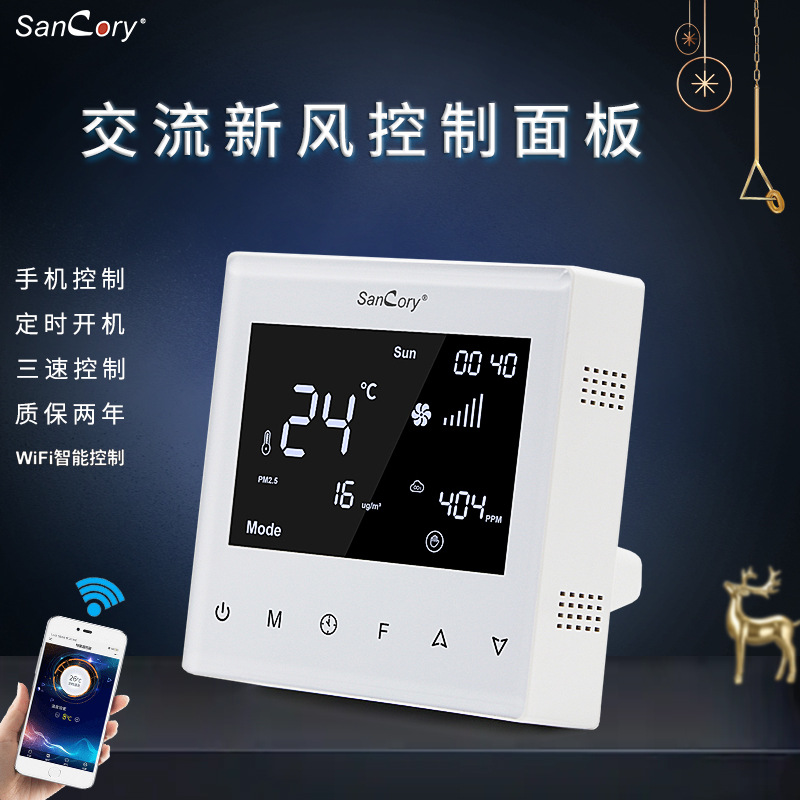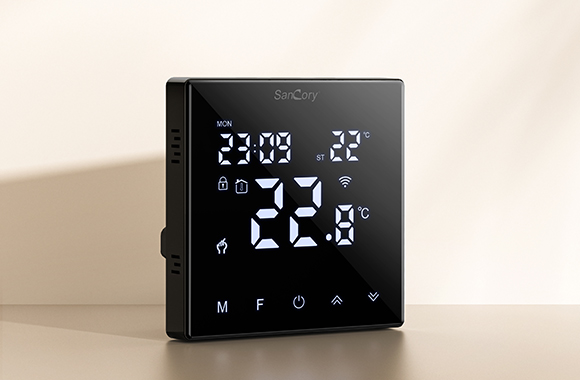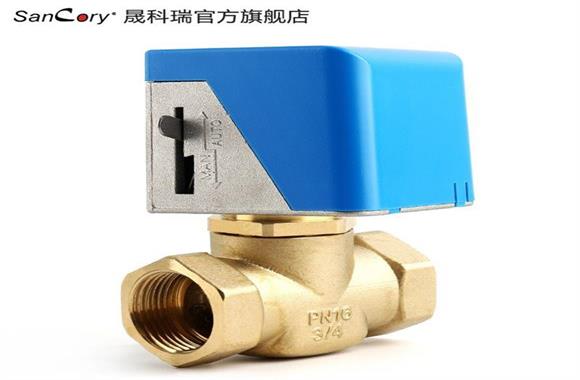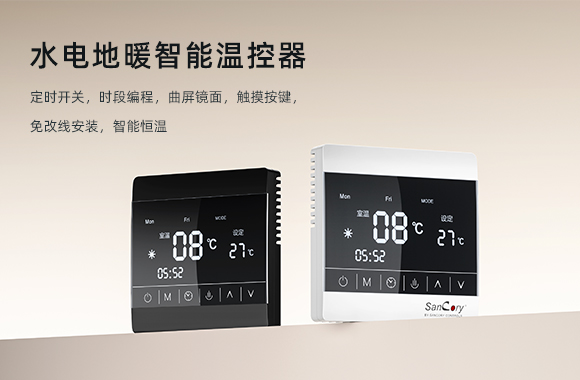无线风机盘管液晶温控器实现智能化控制主要依靠以下几方面的技术:首先是智能算法的应用。通过分析和学习用户的使用习惯和需求,温控器可以根据室内外温度、湿度等环境因素及节能需求,智能地调整风机盘管的工作状态,从而实现更加精准和高效的控制。其次是传感器的应用。温控器内置了温度、湿度、CO2浓度等传感器,可以实时感知环境参数,并根据传感器提供的数据进行控制。再次是无线通信技术的应用。温控器支持无线网络连接,可以与手机、电脑等设备进行远程连接,便于用户通过手机APP或者网页进行远程操控和监控。
实现远程操控主要依赖于无线通信技术的应用。温控器通过内置的无线模块,可以连接无线网络,与用户的手机或者电脑建立远程通信。用户只需要下载相应的手机APP或者通过网页登录,即可实现远程操控温控器。用户可以远程调整风机盘管的温度设定、风速设定等参数,实现远程控制。同时,也可以通过手机APP或者网页查看室内外温度、湿度等实时数据,并进行远程监控和管理。通过无线通信技术的应用,用户可以随时随地对温控器进行控制和调整,提高了使用便利性,也满足了人们对于远程操控的需求。
1、智能化控制的技术方案
智能化控制的技术方案主要包括物联网技术、人工智能技术以及云计算技术。
无线风机盘管液晶温控器可以通过物联网技术实现智能化控制。通过将温控器连接至互联网,可实现与其他智能设备的互联互通,如与智能手机、智能家居系统等进行交互。这样,用户可以通过手机APP或智能家居系统,随时随地对温控器进行远程控制和设定温度,实现智能化操作。
通过人工智能技术可以对温控器进行自学习和智能化决策。通过对用户使用数据的分析和学习,温控器可以根据用户的习惯和需求,自动调整温度和风速,提供个性化的舒适体验。同时,人工智能技术还可以结合外界条件,如温度、湿度、气象等数据,进行智能判断和优化,使控制更加智能化。
借助云计算技术,实现温控器的云端管理和大数据分析。将温控器和云平台进行连接,可以实现数据的实时上传和存储,使得用户、生产商和维修人员都可以通过云端平台获取更便捷的信息。同时,通过大数据分析和机器学习,可以提取更准确的用户需求和设备故障预测,为用户提供个性化的服务和智能维护建议。
综上所述,通过物联网技术、人工智能技术和云计算技术的应用,可以使无线风机盘管液晶温控器实现智能化控制和远程操控,提高用户的舒适体验和能源利用效率。同时,随着技术的不断发展和进步,还可以探索更多的新观点,进一步提升智能化控制的水平和效果。

2、远程操控的技术方案
“The remote control technology scheme for intelligent control of wireless fan coil units with LCD thermostats” invovles the integration of advanced technologies to enable remote access and control of the fan coil units. The following are some key components and steps to implement remote control for intelligent control of wireless fan coil units:
1. Connectivity: The first step is to establish a connection between the LCD thermostat and a central control system or a remote server. This can be achieved using different connectivity options, such as Wi-Fi, Bluetooth, or Zigbee. Wi-Fi connectivity is a suitable option as it offers wide coverage, high data transfer rates, and compatibility with existing residential networks.
2. Smart control platform: A smart control platform needs to be developed or integrated into the central control system. This platform should have features such as temperature and humidity monitoring, adjustable fan speed control, and energy consumption optimization algorithms.
3. User interface: A user-friendly interface should be designed for the remote control application. This interface must be accessible through different devices, including smartphones, tablets, or desktop computers. It should provide real-time information about temperature and humidity, allow users to set desired temperature levels, select fan speed, and monitor energy consumption.
4. Security measures: As remote control involves exchanging sensitive data, it is crucial to implement robust security measures, such as encryption protocols and authentication mechanisms, to protect against unauthorized access and data breaches.
5. Cloud-based architecture: Remote control of fan coil units can be implemented through cloud-based architecture. Real-time data collected by the LCD thermostats can be transmitted to a remote server, where it is processed, stored, and made available for remote access and analysis.
6. Voice control integration: Furthermore, the use of voice control assistants, such as Amazon Alexa or Google Assistant, enables users to control the fan coil units using voice commands for a more convenient and hands-free experience.
To further enhance the remote control capabilities, utilizing emerging technologies like artificial intelligence (AI) and machine learning can help in predicting and optimizing temperature and fan settings based on user preferences, weather forecasts, and historical data. This can improve energy efficiency, reduce operational costs, and optimize user comfort levels.
In conclusion, implementing remote control for intelligent control of wireless fan coil units with LCD thermostats requires the integration of connectivity options, smart control platforms, user-friendly interfaces, security measures, cloud-based architectures, and possible incorporation of AI and machine learning. These technological advancements not only enable efficient remote control but also contribute to energy conservation and improved user comfort.

3、利用无线技术实现智能化控制
无线风机盘管液晶温控器的智能化控制和远程操控可以通过利用无线技术实现。无线技术的快速发展和广泛应用为设备之间的互联互通提供了更多可能性。
智能化控制可以通过物联网技术实现。将无线风机盘管液晶温控器与其他相关设备如传感器、智能家居等连接,形成一个智能控制系统。通过传感器感知环境温度,湿度等参数,并将数据传输给液晶温控器。液晶温控器会根据预设的温度、湿度和时间控制相关设备的运行,并实现自动化的调节,提高能源利用效率和舒适度。
远程操控可以通过无线通信技术实现。基于无线通信技术如WiFi、蓝牙、ZigBee等,用户可以通过智能手机、平板电脑等移动设备远程控制风机盘管液晶温控器。用户通过手机APP、云平台等远程调节设备温度、模式等参数,实现快速、便捷的操作,提供了更加灵活舒适的使用体验。
而且,最新的观点上,应用人工智能技术可以为无线风机盘管液晶温控器带来更强的智能化控制和远程操控功能。通过人工智能算法对历史数据进行学习和分析,可以实现自动学习和自适应控制,根据用户的习惯和环境实时调节设备参数。借助机器学习和大数据分析,还可以预测室内人员的需求,从而提前调整空调设备,节省能源和提高舒适度。
总的来说,利用无线技术和人工智能技术可以实现无线风机盘管液晶温控器的智能化控制和远程操控,提供更加智能、方便和高效的温控体验。

4、液晶温控器的功能和应用
液晶温控器作为无线风机盘管的重要控制组件,具有功能丰富、操作简单、使用便捷等优势。其在智能化控制和远程操控方面可以通过以下方法实现:
在智能化控制方面,现代液晶温控器采用微处理器技术,能够实现温度设定、风速调节、湿度控制等多种功能。通过温度传感器实时监测室内温度,并与设定的温度进行比较,自动调整风机盘管的工作模式,从而实现环境舒适度的智能控制。
远程操控方面,液晶温控器可以通过与智能家居系统相连接,实现远程操控的功能。用户只需要通过手机App或者网页端登录系统,即可实现对无线风机盘管和液晶温控器的远程控制。通过远程操控功能,用户可以随时随地对室内温度和风速进行调节,满足不同季节和场景的舒适需求。
最新的观点,液晶温控器还可以与人工智能技术结合,通过学习用户的使用习惯和偏好,自主调整工作模式,进一步提高室内舒适度和节能效果。另外,液晶温控器还可以与其他智能设备如智能音箱、智能门锁等相连,实现智能家居场景的自动联动控制。
总的来说,液晶温控器在智能化控制和远程操控方面具有广阔的应用前景。通过不断推进技术创新,液晶温控器将进一步提升用户体验,实现更加智能、便捷、舒适的室内环境控制。

深圳市光明区马田街道马山头社区钟表基地依波大厦C203
0755-21020337
13602656010
zhouxiuli@sancory.com













 返回列表
返回列表